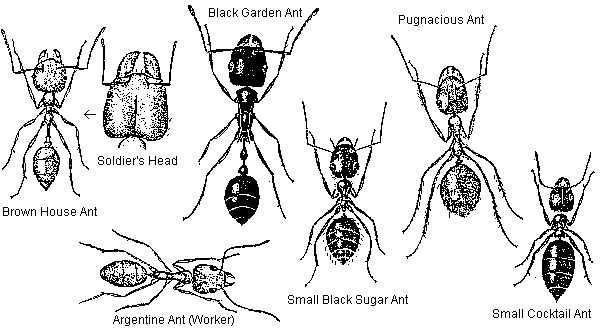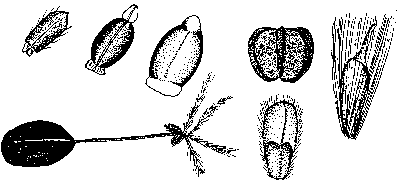
Home
Mission
Overview of Project
Project Staff
Sponsors
Achievements
Checking, Illustrations
Upcoming Activities
Id and Species Lists
Protea Information
Protea Gallery
Growing Proteas
Interim Dist. Maps
Publications
Afrikaanse Inligting
![]()
The Gentle Art of Seed Watching
By William Bond, Botany Dept, UCT
| One of the most entertaining things about proteas is their seeds. These are lively creatures - after pollen the most mobile phase in the life of the plant. If you are a reformed zoologist converted to the delights of plants, but still hankering after some movement, then seed watching could give you many hours of entertainment. |  |
The best place to start is with the seed of pincushions, the Leucospermums. Not the dried up, wrinkle-skinned objects in Kirstenbosch seed packets, but the sleek, glistening, fresh seeds, newly plucked from flower heads. December and January is the best time to search for ripe seeds, (taking care, of course, to choose only common species with many flower heads - seeds are often very rare). Throw four or five fresh seeds onto a patch of open sand in mid-morning or mid-afternoon, sit back and set your eyes for some fine focussing.
After a minute or two you will probably see some aimlessly wandering ants. By random lurches, what statisticians sometimes call `drunkard's walks', the ants at last make contact. Shock!; amazement!; thrill! - who knows what goes on in their tiny minds! Then a sprint for the nearest nest, tap on the portals and out flow the heavies, the mean looking major ants that hover near the entrance, straight to the seeds. Within minutes the scene is a mass of crawling, struggling, frenzied ants pulling and tugging at the seeds from every direction. Astonishingly, order eventually prevails and the seeds are slowly, painfully dragged to ant nests, via numerous detours on the way, until at last they vanish neatly into the entrance hole of the nest.

This is a general outline of seed dispersal by the pugnacious ant, Anaplolepis, the most abundant ant in all but the coldest, wettest areas of fynbos. There are many exciting variations. Battles with other ant species that reach the seed first, heroic single handed treks, standoffs with tree-nesting cocktail ants Crematogaster where no seeds get moved at all; but always entertaining and always instructive.
Myrmecochory, as seed dispersal by ants is called, is one of the most interesting kinds of seed dispersal in the plant kingdom, yet in Africa it is almost confined to fynbos where the Proteaceae provide the most spectacular and highly developed examples. Myrmecochory is distinguished from aimless, accidental seed-dispersal by harvester ants, such as is common, for example, in the Karoo, because myrmecochorous seeds provide ants with a reward in the form of a special food body - a kind of ant fruit - called an elaiosome. Myrmecochory occurs in almost every genus except Protea, Aulax, Brabejum and Faurea. In Leucadendron, it appears to have evolved independently in separate subsections of the genus, occurring in L. nitidum and L. sericeum in the Cedarberg, but also in L. ericifolium and the rare L. olens in the Outeniqua moutains of the southern Cape.
Why should the Proteaceae have adopted myrmecochory so widely? Are there any special advantages to using ants as `removal agents' in fynbos? Cape fynbos, along with similar vegetation in Australia, has the highest frequency of myrmecochores in the world (though only two of the many genera of Australian Proteaceae, Grevillea [grevilleas and silky oaks] and Adenanthos [basket flowers, jugflowers and woody pears], are known to be myrmecochorous). Though the floras of these two regions are distinct, the Cape and Australia do share impoverished sandy soils, shrubby evergreen vegetation and fire. Just why myrmecochory should be so favoured in these habitats remains a mystery. We know that rats and mice are quick to find seeds missed by the ants and eat most seeds from which the elaiosome has been removed. In areas infested by the invasive Argentine ant, disruption of the race for seeds can lead to regeneration failure of proteas, because the ant does not bury the seeds in its nests where it would be hidden from hungry rats and mice.
Myrmecochory is undoubtedly important for the seeds of many species as a way of avoiding being eaten. In Australia, however, seed-eating small mammals are apparently rare, yet myrmecochory is still common. The plot thickens! Some people have suggested that ant nests have more nutrients than normal soils giving the young seedlings a boost in this harsh environment. So far, however, we have found no evidence for this. In fact the reverse applies because ants carry seeds away from their parents, which have enriched the soils beneath them with leaf litter, to less fertile soils in the open. Others have suggested that the powerful fungicides in ant nests protect the seeds and seedlings from fungal diseases such as phytophthora.
Ants are not always reliable. On cold, wet or windy days ants stay at home. But the veteran seed watcher can still be entertained watching the other major agent of dispersal in fynbos - wind. If you survey an unburnt stand of fynbos, with its typically patchy array of Proteaceae, imagine your options as a plant hoping to colonise that pristine unoccupied patch on the next hill? Wind dispersal is tricky, since the vegetation often forms barriers. Many Protea, Leucadendron and all of the Aulax species avoid the problem by storing seeds in the canopy of the plant, in cones or woody flower heads (these are the easy ones to collect seed from). Fires trigger the mass release of seeds into a very different world from the one of their inception. Without the leafy barriers of neighbours and the tangled mat of restios and ericas, seeds can be carried much greater distances by wind. The conebushes are by far the most intriguing, with a great diversity of seed shapes and sizes related to wind dispersal. Most are winged-some, like L, playtspermum, spectacularly so; some mimic dandelions with small parachutes; others are covered with long hairs resembling Protea seeds, or form round, woolly balls. Some are nuts with neither eliaosomes nor wings: their dispersal remains a mystery.
Why is there such diversity? Does it influence distribution patterns and the movement of populations? Will some kinds of seeds recolonise areas devastated by the "wrong" types of fires more easily than others? Different seed shapes and sizes do influence the flight patterns of seeds. Lower wingloadings lead to longer flight times and greater distances traversed. Flight patterns of winged fruits are complex, with rotating blades (such as sycamore) behaving a little like helicopter rotors developing slight lift. Instead of contemplating falling apples, Newtonians might try dropping a handful of assorted Leucadendron seeds for entertainment. Hairy seeds, such as those of Aulax, Protea and some Leucadendron species, are capable of moving great distances by rolling over the ground. If you have never really believed that the parachutes of the silver tree (L. argenteum) are any use for wind dispersal, (or the hairs of Protea, Aulax and sundry other species) you might like to set up a race between parachute, winged, hairy and nut seeds placed in a row on a sandy beach on a windy day. Our record for a Protea was 1 km when we, but not the seed, gave up the race.
Of course "life is not a beach" and in their habitat the seeds will usually bump up against some barrier. Nevertheless, the "tumble" seeds of Protea can potentially move hundreds of metres, compared to distances of 2-10m characteristic of myrmecochores. Some recent studies show that the barriers which stop Protea seeds are often the skeletons of large shrubs killed by fires, including those of the myrmecochorous Proteaceae. Perhaps one of the great benefits of ant dispersal is that the ever-caring ants carry seeds to warm, sunny nest sites in the open - just those sites where Protea seed is least likely to come to rest! The conservative behaviour of the myrmecochore seed may thus neatly complement the roving lifestyle of proteas.
As I hope this account makes clear, there is still much to learn from the gentle art of seed watching and much entertainment to be had. The brief moments of freedom as seeds disperse from their parents could hold the key to an understanding of the ecology and biogeography of our Proteaceae.

Back Phloeonumus Corner